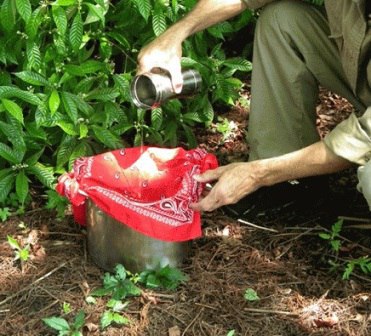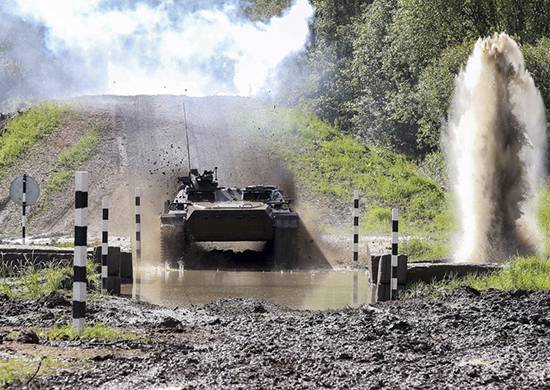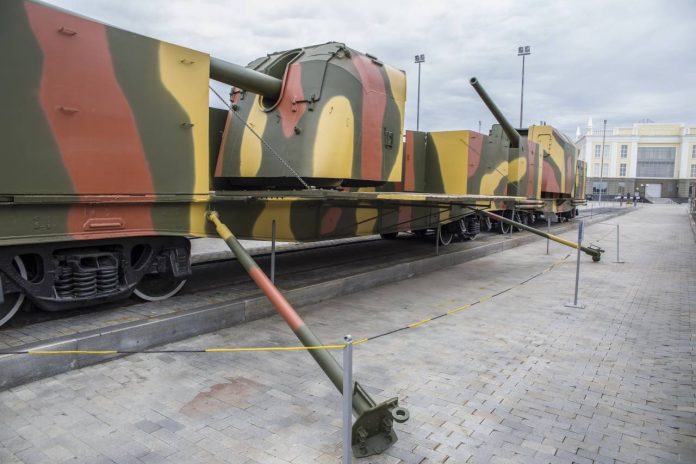
AT previous article we looked at the components of armored trains. Attentive readers will notice it is quite reasonable for a mismatch broneploschadok and names of BP, and hurried to pass already offered to tactics.
Really, heavy armored train, composed of light broneploschadok, - is nonsense. A transition to the tactics of the armored train without setting all points too, nothing good can not be held over the letters of a.
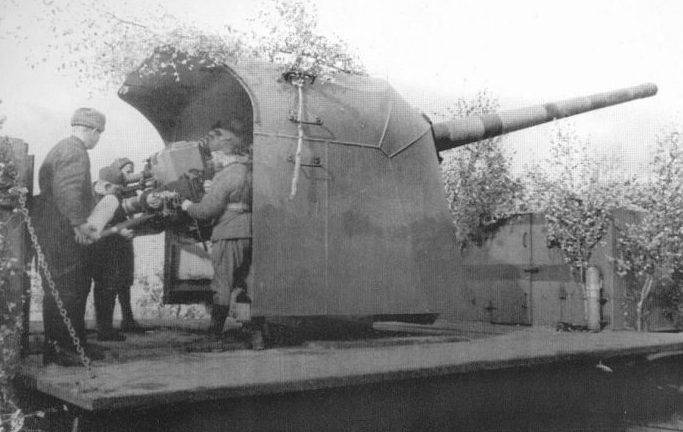
Naturally, to the use of armored trains we come. Especially we have a minimum of three beautiful story. But - in order and without haste. Armored train - a thing difficult, and rush on it, and with it does not always work effectively.
So we are not going to do it.
That is why today the conversation is going on heavy broneploschadkah, the arming of larger caliber and its purpose. The war revealed the need for specialization of armored trains, respectively, on different theater they staged a completely different problem. In these circumstances, the railroad invent some incredible platforms and cars.
Really just fall into a stupor, and the only question, which breaks with the lips: hell, here's how? Here's how you can come up with, calculate and create?
We must start with the heavy broneploschadki, which we developed on the already known to us a military warehouse №60. It is known by just two designations. Heavy broneploschadka UT-33 and heavy broneploschadka sample voensklada №60. by the way, figures 33 - just a tribute to tradition. taking the time to adopt, and an analogue with PL-35. In fact, the production of these areas was begun in 1931 year.
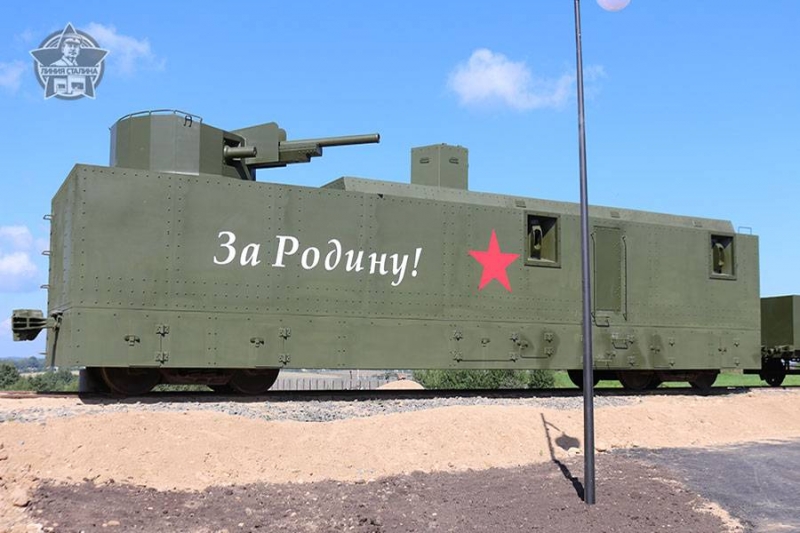
The name "hard" says, that the system should be sufficiently large caliber. Really, experts workshops voensklada armed its ground 107 mm gun of the sample 1910 of the year. To combat enemy infantry sets out five machine guns "Maxim". One of the tower and 4 on the sides to "Verlyuz" installations.
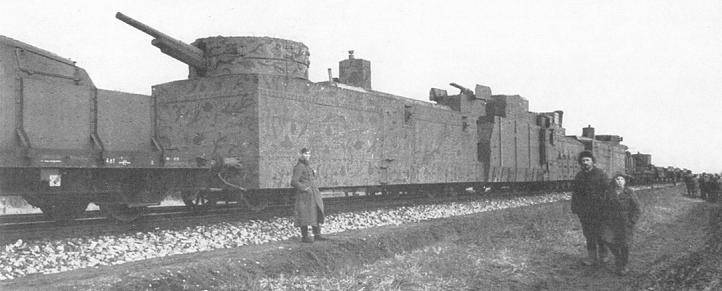
If you look closely on the PT-33, then determine the "parents" of this platform is not difficult. BP-cylindrical tower 35 copies tower PL-35 easy platform, but increased in size. booking 20 mm. Cannon and machine gun. commander's cupola.
Besides, clearly seen quite a number of hatches. The sides of the tower can be seen 6 bivalve hatches, and in the back of the large hatches. Purpose is the prosaic - small hatches for ventilation, and great for the dismantling of guns on the repair case.

Planting crew carried out through two doors in the sides. And the doors were offset from each other for safety in case of fire armored Small Arms. It was provided and the way emergency evacuation through the floor PT. There is a sufficiently large exit hatch.
Reservation sides of the site - 20 mm. Reservation roof - 16 mm.
This modification severe broneploschadki suited the command of the Red Army. That is why, except voensklada number 60, PT production was entrusted more and the factory "Red Profintern". Hence the difference in the title, We mentioned earlier in this article.
Workshops military warehouse number 60 fabricated 16 heavy broneploschadok type voensklada № 60, and the factory "Red Profintern" manufactured 10 PT-33 (heavy broneploschadka 1933 of the year). And in 1935 both names are replaced by the PT-35 designation. In some sources you can find number 27 units. This is taking into account the experimental sample.
The development of heavy broneploschadok continued later. The were released PT-36 and PT-38. PT-36 differed from the "mother" tilt bronelistov (8 degrees) and the presence of anti-aircraft M4 (quad "Maxim"). The special anti-aircraft gun was used in the design of armored trains for the first time.
Sheer installation work scheme did not differ originality. The unit is located in the opposite end of the car from the tower and had a sliding design. To use it was necessary to move the manhole cover and lift installation. Respectively increased and PT crew, to 23 human.
PT-38 differed install another gun, M-60, 107-mm rifle Countdown. 1940 of the year. Talk about the reasons for, which is not a bad gun stopped making, not the topic of this material. However, for the production of PT-38 this circumstance was fatal. Released a single unit, and that she had participated in World. by the way, reviews were very good.
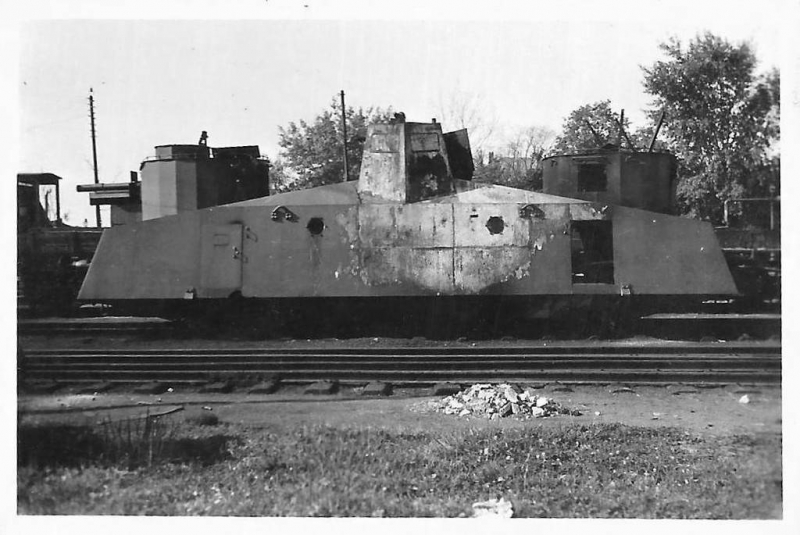
The Great Patriotic War has set the command of the Red Army and the designers a completely new challenge. Trains have proved to be really necessary edge. Many of the compounds stopped by the enemy at the cost of his own life. Many were the "last chance" for the army surrounded parts. Many single-handedly defended the railway junctions and stations.
truthfully say, exactly who got the idea to use the towers to create the finished broneploschadok, impossible. In this case, it solved several problems. Sheathing bronelistami platforms are not the most difficult task. But the installation of large-caliber guns on the platform - a real problem.
Even in the pre-war period, solving the problem of rapid deployment of large-caliber guns, designers began to use for this purpose, ready-sea tower with guns. Such tools often acted independently, because it is quite a formidable force, and were divided into separate parts and units with the subordination SHAPE rate.
On the military inventions can talk a lot. Necessity is the mother of invention. We'll only some. And the first such gun mount will be a 130-mm gun B-57. 36 installations of this caliber - a measure.
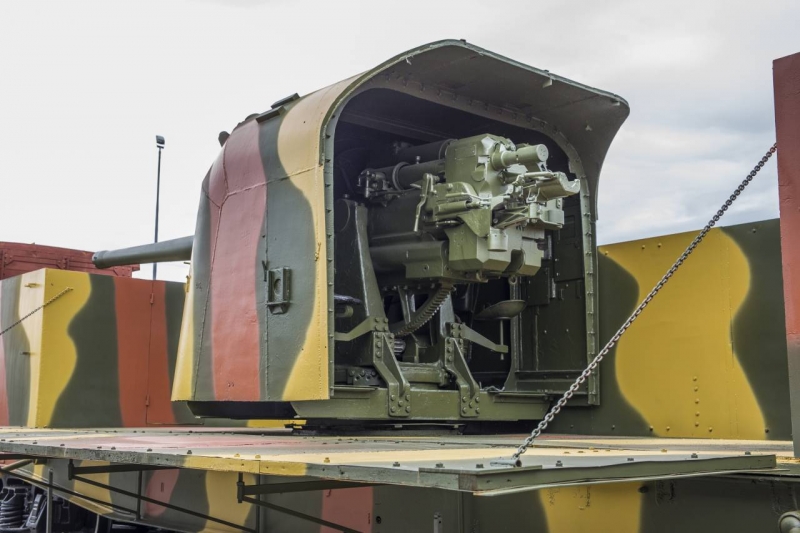
so, the idea of such a plant was born as early as 1939 year, in the walls of the Artillery Research Maritime Institute (anime), subsequently the Research Institute of the Soviet Navy. Then it began pilot production test.
The idea was to set naval gun B-13 on the frame rail. The difficult fate of the gun, about which we will talk separately, It played a positive role for railway project. The tower was easy enough. With a little (13 mm) booking. In this case, with a huge for the railroad gauge.
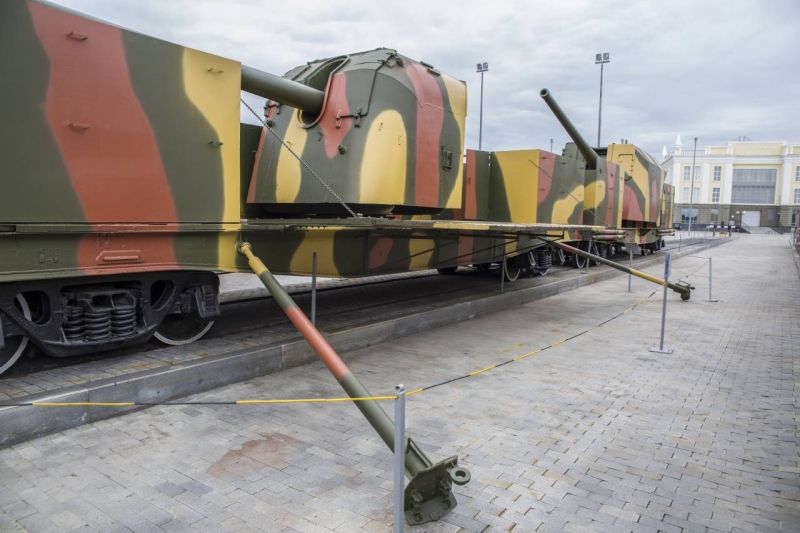
It is worth mentioning that, itself turret had two modifications. Confuse them quite difficult. first, B-13 case, It has box-shaped shield. second, basic, modification of the more familiar to us (B-13 IIs) It has oval contours streamlined. One more thing, B-13 - the most common instrument of medium-caliber period of the war.
First, 1939 of the year, sample turned out unsuccessful. The reason for this platform. The designers used the biaxial platform with some technical modifications. Simply put, platform strengthened mechanically. Thereby more increasing its weight. The conveyor was equipped with four support legs, and shells were placed in iron boxes in the frame.
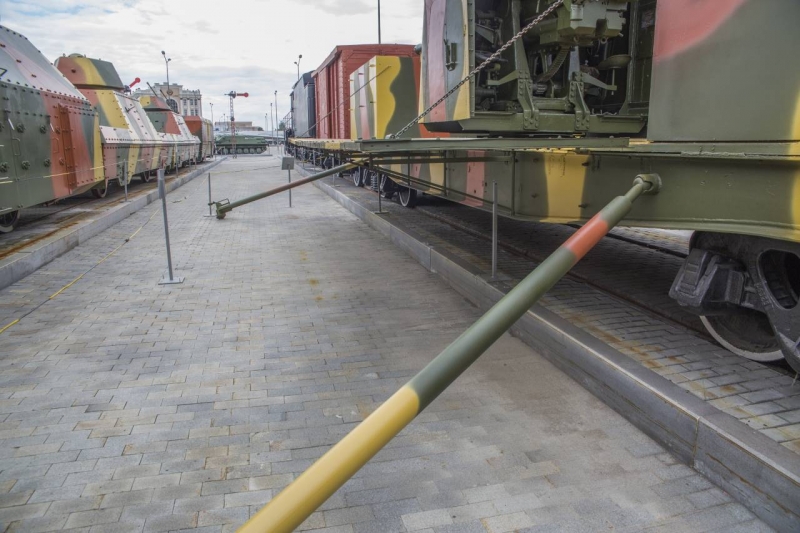
In fact, the completion and production of these plants began only in 1941 year. In Leningrad, taken from ships naval guns B-13 was set at 4-osnuyu railway platform virtually unchanged. Even armor shield is not strengthened.

If the meticulous reader will want to see documents 1941 year are conveyed B-57, it will be unpleasantly surprised. This name is not there. There is another name for this object - YB-57. Yes, and in the orders of the time you come up with interesting symbols. "Commander UB-57-2 come ..." Only the index B-57 appears at the end of the year. A "dvoechka" in order - just a battery room.
Total Leningrad built 36 such facilities and they have been used, naturally, on the Leningrad front. In the photos you can see the front-line correspondents mismatch narrated fact. B-13 set just unprotected railway platforms.
Alas, but it also happens. Leningrad lacked armor steel, and therefore part of the conveyor practically BOOK. In fact, only the tower was protected. Yes, and this protection (13 mm) conditional enough ...
But, viewing photos from the field installation work, the authors came to the interesting, but quite controversial conclusion. B-57 is sometimes masked by picket fence ...! ordinary, can, slightly increased in size, but picket fence! AND, judging by the photos, disguise was good enough.
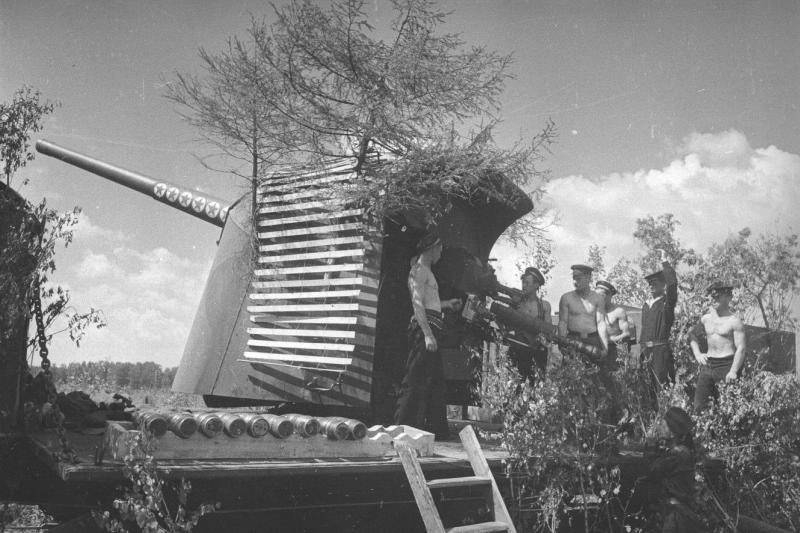
Remain traditional TTX:
caliber - 130 mm;
gun weight - 12,8 t (7,2 ie without shield);
Barrel length - 6,5 m;
weight with lock barrel - 2,5 t;
projectile mass -33,4 kg;
mass of the charge - 10,8 kg;
the initial velocity of the projectile - 870 m / s;
rate - 6-12 rounds per minute;
shooting range - 25,6 km.
And one more very powerful artillery unit at the time - TM-1-180. This is one of the most popular plants of the Soviet railway artillery. At the beginning of the war in the Soviet Union they were armed 5 Battery-gun 3-4 composition (12, 16, 17, 18, 19).
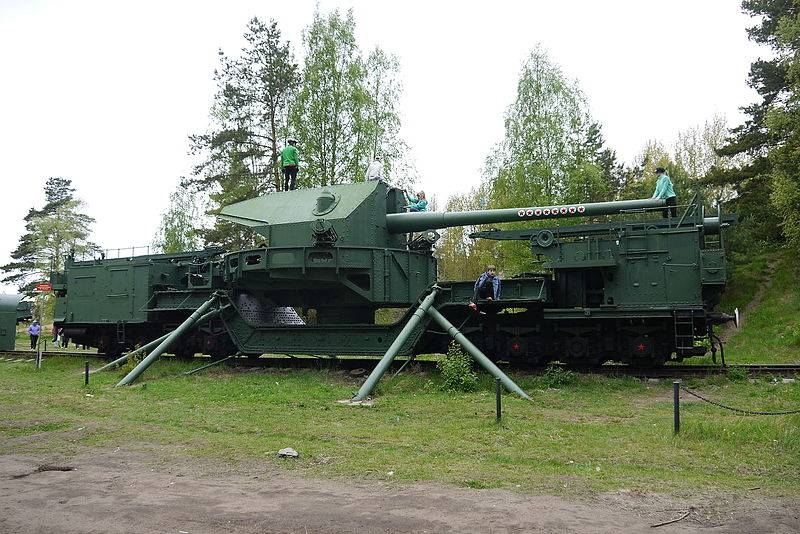
Development of 180-mm coastal artillery installation began in 1931 year. Basing on the w / e platform to provide further opportunities of solving problems and the Army.
Like other rail guns, basis TM-1-180 construction is a railway transporter. It consisted of a main beam, based on two four-axle rail bogie.
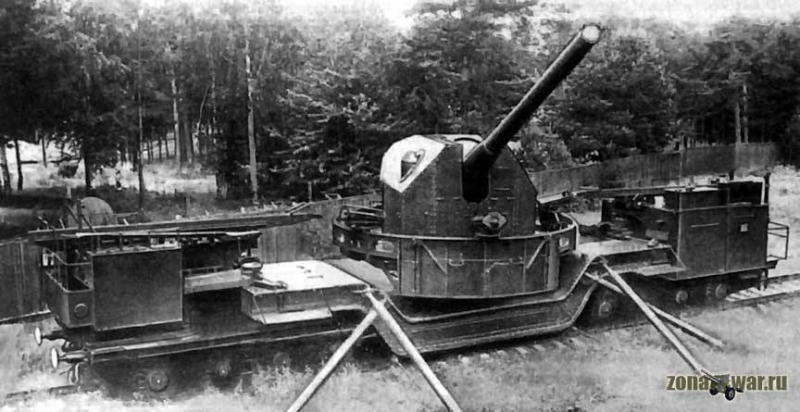
The beam was provided with eight supporting legs reclining, in its middle part was mounted on the rotating bed 180 mm gun B-1-P, with a barrel 57 calibres, which was also used in one coastal artillery tower installations MO 1-180 and ship three gun tower installations MK-3-180, designed for cruisers Project 26 ("Kirov").
Manufacture of guns was organized at the Leningrad plant "Bolshevik".
For supplying ammunition to the gun supplied with ammunition transporter platform, which rotates with the instrument. The wagons-cellar located at the front and rear conveyor, and supply of ammunition was carried out with any of them.
Between cars and rocket platform positioned roller tables with wooden rollers. According to him the shells of the cars fed manually onto the platform.
For poluzaryadov next to the roller conveyor has been installed chute. The loading was carried out on vertical guidance angle + 10 °, I was given the same angle and trays.
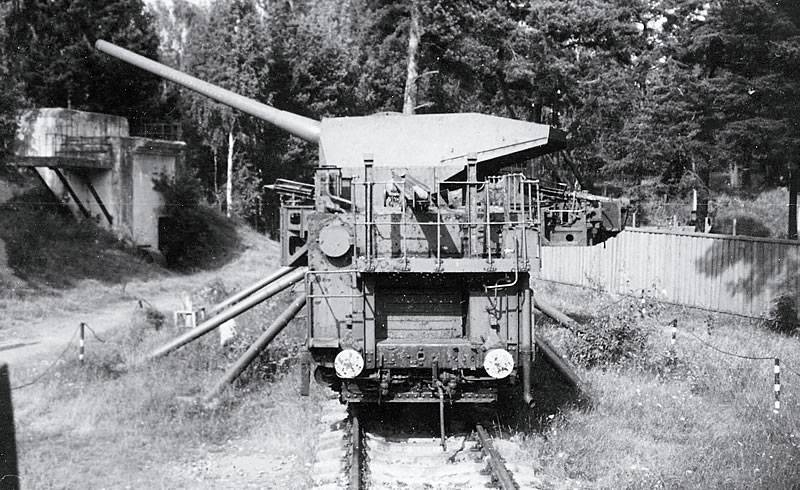
For the convenience of placing workers at the loading platform of shell it was installed on the main beam with a small eccentricity relative to the system axis of rotation.
Therefore, during the traversing platform changed its position relative to the roller table, and had to continuously move the roller, tracking the movement of the platform. This was a serious lack of ammunition feed system, but with appropriate training failures and delays in the shooting has not been.
To slug the platform does not extend beyond the width of the rail clearance, it was divided into two parts. In the transition from combat to the stowed position, they turned on the vertical axis of 180 ° and placed directly under the instrument, which is in the stowed position was sent to the end of the composition.
conveyor design allows you to keep a circular firing from every point of the railway track without engineering equipment fire position. To this end, the main beam fell on special boards, which is installed on the railway track sleepers. Bars were recruited from oak boards and contacted by bolts and brackets.
During the war, as part of the TM-1-180 Leningrad front were three batteries of 180-mm plants: 12-I, 18-th and 19 th. 16-I pack early in the war ubyla the Black Sea, and the 17th was blocked on the peninsula of Hanko and later during the evacuation of the Hanko garrison its transporters had to incapacitate. Simple and without frills blowing.
Another invention of wartime Leningrad - Rail Installation B-64 (TM-1-152). The number of these installations can not boast. Total 4 pieces. And the name they are not changed in the proceedings. But caliber is impressive. 152 mm! And set a gun on a simple platform is also impossible. Only a special conveyor.
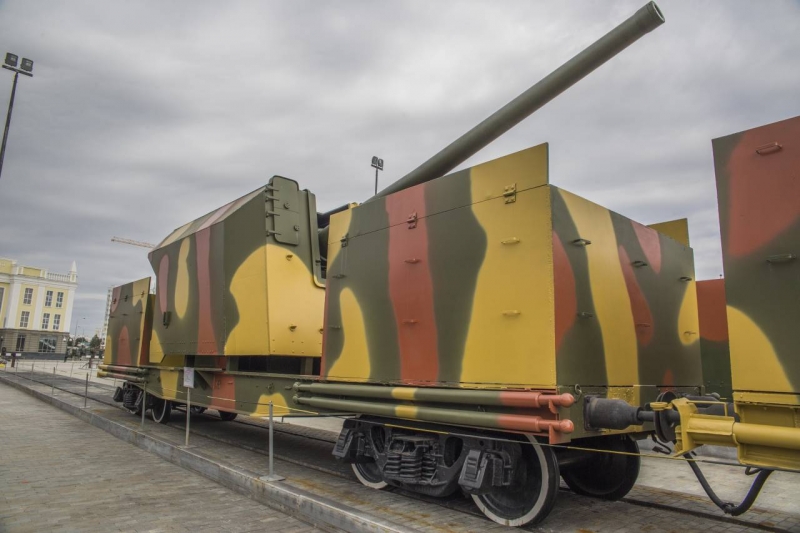
AT 1941 g. 4 for rail-axle platform installed in warehouses available marine 152mm gun "Kane" and naval guns "B-38". Transporter largely repeat the TM-1-180 construction. Cellars in the form of metal boxes located on the main beam, therefore ammunition fed by hand.
The guns were installed on the machines from 203/45 mm guns Kane. Panel cover constituted tower "ME-2" (frontal armor thickness - 50 mm, roof and side armor - 25 mm).
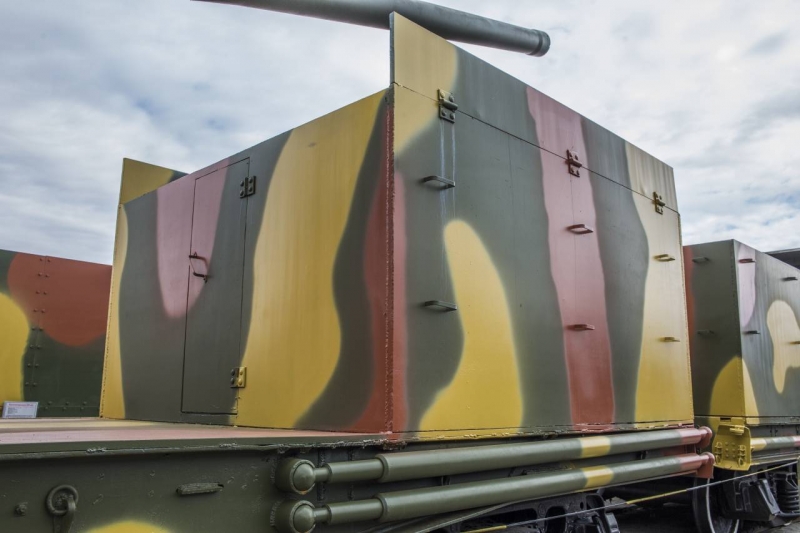
Transporters have four supporting "legs", is pivotally fastened to the platform. There were built 4 install. Settings, issued in 1941 g. designated as T 1-152, and 1943 g. - B-64.
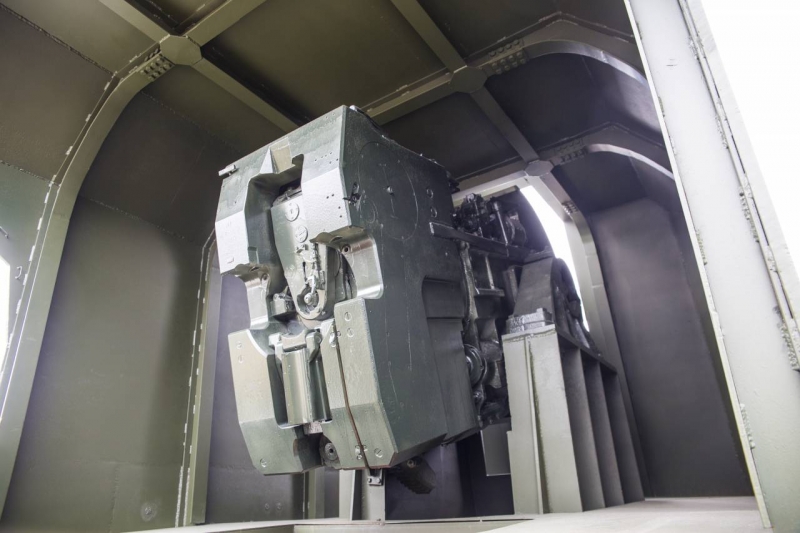
TTX installation:
caliber - 152,4 mm;
Setup mass - 16,6 t;
Barrel length - 8,7 — 8,9 m;
weight to the gate of the trunk - 12 t;
projectile mass - 48,5-55 kg;
mass of the charge - 24 kg;
starting speed - 950 m / s;
rate - 6-7 rounds per minute;
shooting range - 28-30 km;
payment - 10 human.
But, except for mobile artillery batteries, Some armored train is a mobile anti-aircraft batteries. Just because, that railway junctions simply no longer be defended. here, acutely apparent the need for rail air defense.
It seems to be strange to write, but before 1941 , the defense of trains in the USSR was not. Construction zenith and train formation was initiated in accordance with decision of GKO 23 November 1941 of the year.
Here it is necessary to make a historical reference. To understand why, GKO prompted to take such a decision. Only numbers.
for the first 4 months of the war were evacuated two-thirds of the Soviet Union's economic potential (more 1500 large and medium-sized enterprises), about 28 million. human.
It moved to the front 291 Infantry Division, 94 rifle Brigade, over 2 million. people from marching reinforcements.
People's Commissariat mobilized 30 thousands of compounds (15 000 cars). It is on our side.
On the other hand: Germans committed during the war 19 863 bombing raids involving around 60 thousands of aircraft, discharged more than 243 thousand. tons of high explosive, fragmentation and more 120 thousand. tons of incendiary bombs.
On the territory of the USSR was destroyed: 65 thousand. kilometers of railway tracks, 13 thousand. bridges, 317 locomotive depot, 15 800 locomotives and rail car, 4100 railway stations and facilities.
The war between the aviation and railways require special protection. such, eg, how to train air defense.
PVO train formed from special armored bay (booking 15 mm, biaxial) and railway platforms fitted with the usual guns and machine gun.
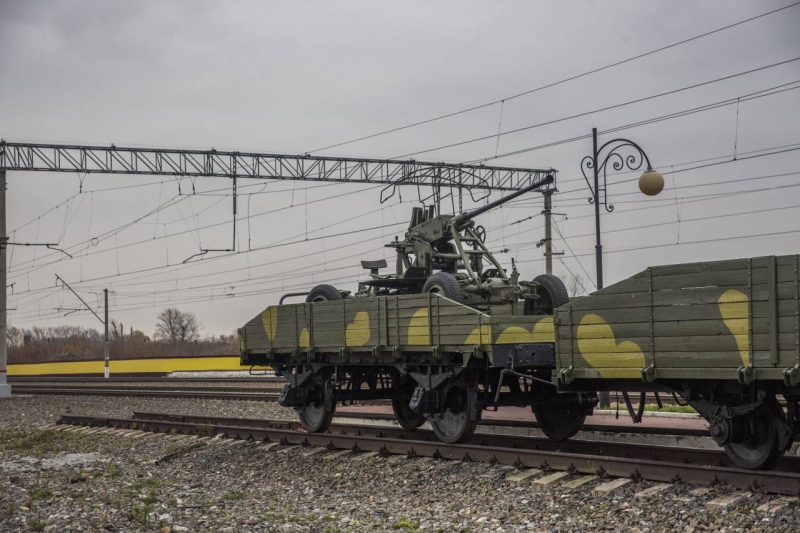
We use a variety of guns: 85-mm (Countdown. 1939 city), 76-mm (Countdown. 1938 city), 37-mm automatic anti-aircraft gun (Countdown. 1939 city), large caliber 12.7 mm DShK (Countdown. 1938 city), quad easel 7.62mm machine gun "Maxim" M4 and even twin and triple guns DT / DA and other exotics.
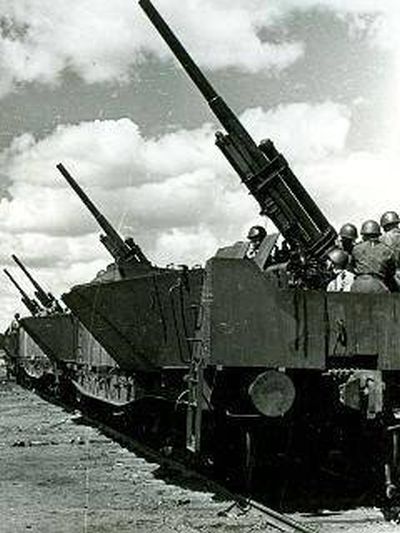
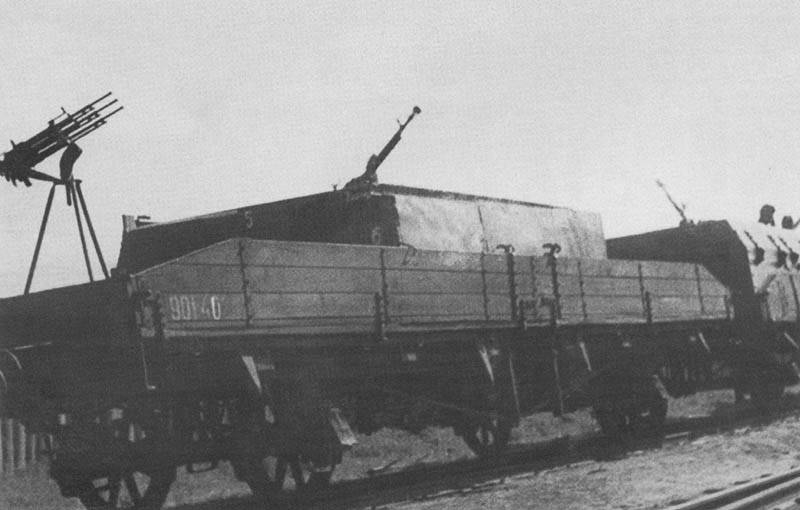
Generally, all, that could cause harm to enemy aircraft.
Tandem platform with the installed anti-aircraft gun K-61 is not an invention. This really existed and been used with success.
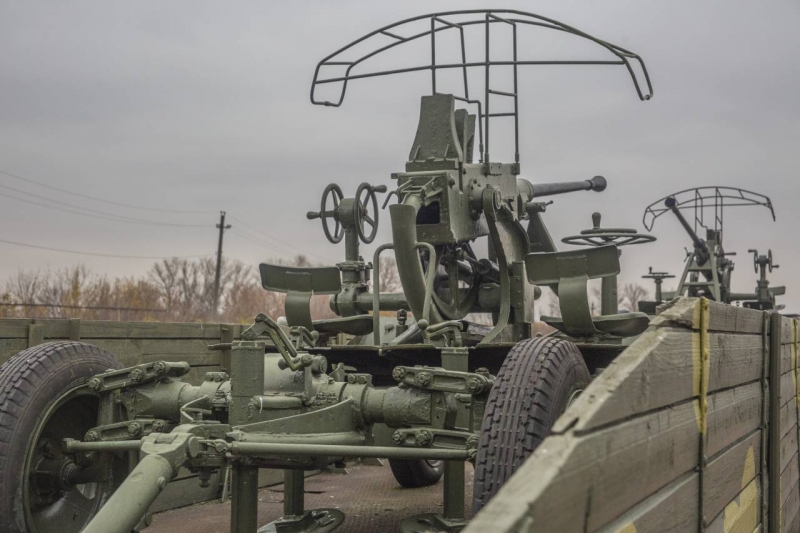
The thing is, that is properly fastened and do not have a big impact K-61 is quite able to fire from the platform. And when returning to the home base station, a tool can be removed from the platform, set the gun on the ground and continued to carry out their functions to protect against threats from the air in the event, if the train had, eg, go to the depot for repair.
Four barrel caliber 37 mm were never superfluous. At all, PVO is never too much, proved that war. Someone says, four 37-mm machine - not great in terms of the density of fire. A quad "Maxim" and generally archaic.
Unfortunately, bit of truth in this. And not from the good life we all looked so, but because the defense was really a very weak point in the Red Army. But four 37-mm cannon - it's better than nothing. And four "Maxim" were able to tear away from dive "thing" as, that "Junkers" ceased to be an airplane. Checked Rudel, it to the third or fourth time so brushed from the sky.
Well, it is worth mentioning existed in single copies hybrids. This is when the seemingly anti-aircraft platform with guns K-61 was placed in the middle of launcher rockets BM-8-24.
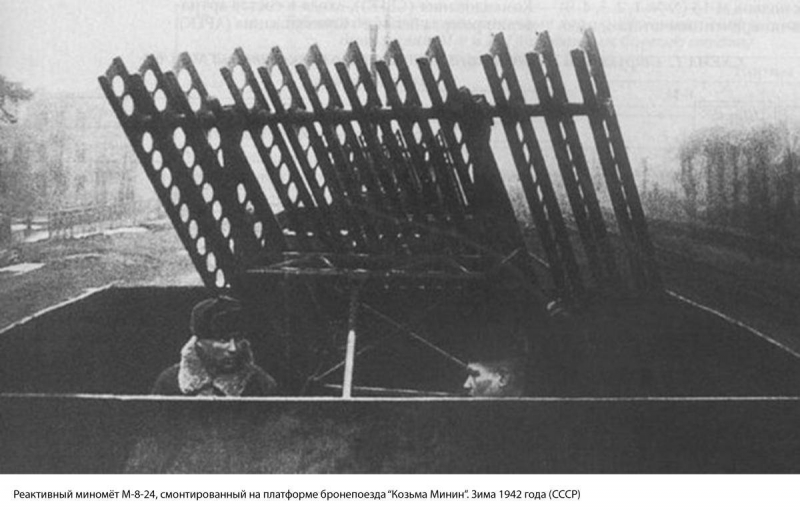
Such armored bay was made in all four. They were produced in Nizhny Novgorod and fought in the armored train "Ilya Muromets" and "Kozma Minin". It is thanks to their defaults "Ilya Muromets" sent to the scrap "Adolf Hitler", but this is a wonderful fight, we will talk separately, because the battle was really interesting and original in terms of tactics.
Up to now did not live platform, there is, true, the layout of a part of an armored train on a black station in Tula region.
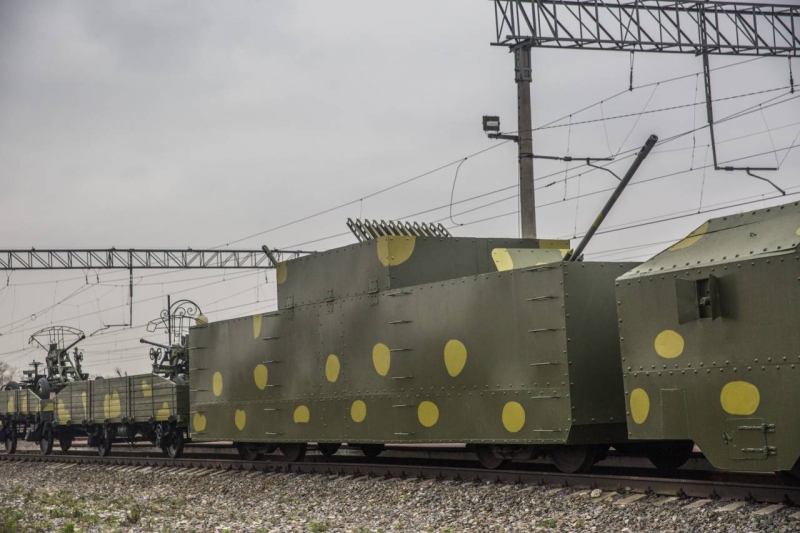
On the whole,, speaking of armored trains of Great Patriotic War, we are talking primarily about the diversity. About sharpness and golden hands of our ancestors, Makes combat units out of nothing, because it was very necessary.
It is very difficult to catalog and organize the (armored train), that was created "in the teeth" from the, what happened.
We can only respect the titanic work and keep the very merits of history as creators of armored trains, and these original fighters and their crews.
To be continued…








